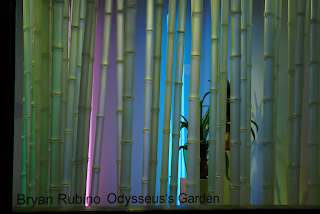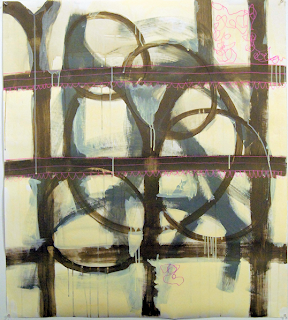
A forest of bamboo in glass
Published in the Weekly Volcano, July 31, 2008
Pictured: "Winter Bamboo," blown glass by Bryan J. Runbino
Photo: Corey Lund
The front rooms of Fulcrum Gallery are filled with glass works by Bryan Rubino that are displayed in such a way as to be seen as two unified installations even though it is actually an exhibition of slightly more than a dozen individual works of art. The placement of the pieces adds considerably to their impact, as does the lighting, which requires some fine-tuning because the art is reflective and some works have their own light sources. And there is natural light to contend with, which filters through the large front windows. I’m told that the installations look spectacular at night, but I haven’t had the privilege of seeing that for myself.
The alcove on the left is partitioned off by an L-shaped forest of bamboo stalks made of ruby red glass and standing about seven feet tall. Another stand of glass bamboo stands across an opening into the little alcove area. This one is a stand of bright green bamboo on a circular base. These two stands of bamboo wall off that section of the gallery leaving a wide entryway into a square space with colorful glass flowers along two walls. The glass flowers are bright purple, green, gold and red — colors that harmonize beautifully with the red and green bamboo. There are also three groups of clear glass sculptures on pedestals called Ocean Life. These pieces are shaped like fronds of sea grass flowing in water; they are nice forms but much less interesting than the bamboo and the floral pieces on the wall. As individual pieces, they are pretty but not exciting, and as part of a unified installation, they are distracting. That is to say the display would have been better without them.
The other half of the front gallery consists of similar and even more exciting groups of glass art. Facing the front window and partitioning off part of the room is another L-shaped stand of bamboo stalks. These are clear, frosted glass. Facing them against the back wall are three sets of bamboo in neon and glass. To the left, a group of three luminous green bamboo stalks; in the center a group of four brilliant pink stalks; and to the right five intense blue stalks. And as on the other side, the imposing forests of glass bamboo frames more traditional floral-inspired glass art, including two glass flowers in turned wood pots, a collaboration with wood artist Dave Schweitzer.
This is glass art on the cutting edge, and it is quite beautiful.
Gallery owner Oliver Doriss pointed out that these are not pieces that would fit well in the average person’s home. They are quite expensive and rather large and overpowering. They are more appropriate to large commercial spaces and are, in fact, more architectural than decorative.
In the back room there are more of Rubino’s bamboo pieces and a group of more traditional glass bowls and vases in the Venetian art tradition. Perhaps a more exact definition would be the Venetian-American tradition, which melds the influences of Venetian glass artists such as Lino Tagliapietra and the American glass artists of the Pilchuck School. Some of the most beautiful pieces here are a couple of twisted cane pots with beautiful and delicate coloration. For the uninitiated, twisted cane is a glass blowing method in which rods of different colored glass are twisted and spun in delicately flowing patterns.
There is also one more large standing bamboo work in this room. This one has groups of tall bamboo stalks on a semicircular base in brilliant colors including green, brown, yellow, and red. As a stand-alone work, I think this is the best of the bamboo pieces.
Whether you’re into avant-garde installation art or traditional glass vessels, Rubino excels in both. This is definitely a show worth seeing.
[Fulcrum Gallery, noon to 6 p.m. Saturday-Sunday, 6-9 p.m. Thursdays, and by appointment, through Aug. 17, 1308 Martin Luther King Jr. Way, Tacoma, 253.250.0520, fulcrum@oliverdoriss.com]






